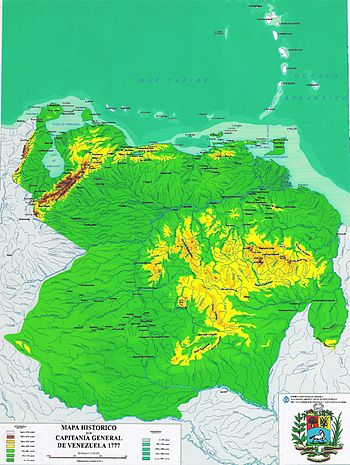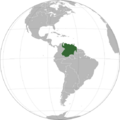Captaincy General of Venezuela facts for kids
Quick facts for kids
Captaincy General of Venezuela (Kingdom of Venezuela)
Capitanía General de Venezuela (Reino de Venezuela)
|
|||||||||||||||||||
|---|---|---|---|---|---|---|---|---|---|---|---|---|---|---|---|---|---|---|---|
| 1777–1824 | |||||||||||||||||||
|
Coat of arms of Caracas
|
|||||||||||||||||||
 Flag of Spain: first national flag, naval flag since 1785 and fortress flag from 1793, and the last Spanish flag to fly in continental America, in San Felipe Castle |
|||||||||||||||||||

Captaincy General of Venezuela in 1777 (Projection).
|
|||||||||||||||||||

Map of the Captaincy General of Venezuela in 1777.
|
|||||||||||||||||||
| Capital | Santiago de León de Caracas | ||||||||||||||||||
| Common languages | Spanish (official) Wayuu, Pemon, Warao, Yanomamö |
||||||||||||||||||
| Government | Captaincy / kingdom | ||||||||||||||||||
| History | |||||||||||||||||||
|
• Royal Decree
|
September 8, 1777 | ||||||||||||||||||
| April 19, 1810 | |||||||||||||||||||
| 1824 | |||||||||||||||||||
| Currency | Spanish colonial real | ||||||||||||||||||
| ISO 3166 code | VE | ||||||||||||||||||
|
|||||||||||||||||||
The Captaincy General of Venezuela (in Spanish: Capitanía General de Venezuela) was a large area in South America. It was controlled by Spain during its colonial rule. It was also known as the Kingdom of Venezuela. This area was created on September 8, 1777. This happened through a special order from the King of Spain called the Royal Decree of Graces.
This new setup gave the provinces in Venezuela more independence. Before this, they were managed by other larger Spanish territories. The Captaincy General brought all parts of the government under one rule in Caracas. This included political, military, financial, church, and legal matters. This change was part of bigger reforms by the Spanish royal family. It helped shape the country that would later become modern Venezuela.
Contents
History of the Captaincy General
How it Started
The Spanish royal family, called the House of Bourbon, wanted to better organize their lands overseas. Venezuela was one of these places. In 1739, the governor of Caracas was given military control over several provinces. These included Maracaibo, Cumaná, Guayana, Trinidad, and Margarita.
The 1700s were a time of strong economic growth for Venezuela. Many cocoa farms were started in the valleys near the coast. This led to many people being brought from Africa to work on these farms. A company called the Real Compañía Guipuzcoana de Caracas helped this cocoa trade grow. This company had a special right to control all exports and imports starting in 1728. They also exported a lot of tobacco. The company also encouraged people to explore and settle new areas. This included the Expedition of the Limits, which led to new towns in Guayana Province. However, this growth was not fair for everyone. Small farmers often sold their goods illegally because the company's control hurt them. This led to a revolt in 1749, led by Juan Francisco de León.
Setting up the New Government
The Captaincy General was like a new, smaller kingdom, but it was not called a viceroyalty. It was built step by step by bringing all power to Caracas. The first step was creating the Intendancy of Caracas in 1776. An Intendancy was a special office that managed money and military supplies. This new office covered several provinces. These included Venezuela (Caracas), Cumaná, Guayana, Maracaibo, Trinidad, and Margarita.
Before this, Maracaibo, Guayana, and Trinidad were overseen by a court in Bogotá. The other provinces were overseen by a court in Santo Domingo. The next year, a joint governor and military commander was put in charge of these same provinces. All local governors and military leaders had to report to the governor in Caracas.
To make legal matters simpler, the provinces of Maracaibo, Margarita, Cumaná, Guayana, and Trinidad were moved to the Santo Domingo court in 1777. This court had handled appeals from Caracas since 1742. Finally, in 1786, all legal matters were brought together. This happened with the creation of the Audiencia of Caracas. An Audiencia was a high court. It had power over all these provinces and a new one called Barinas. This court had a main judge, three other judges, and a lawyer for the king. The governor of Caracas was the president of this court. Its job was to make sure justice was served and to watch over royal officials. It only reported directly to the King's Council in Spain.
In 1793, a special trade organization called a consulado was set up. It oversaw all trade for the new Captaincy General. In church matters, all provinces were placed under the new Roman Catholic Archdiocese of Caracas in 1803. Two new church areas, Mérida and Guayana, were also created. Before this, parts of Mérida were under the Bogotá church area. Guayana was part of the Puerto Rico church area. The Spanish lost control of the Province of Trinidad to the British in 1797.
Laws That Created the Captaincy General
The King of Spain made a special order on September 8, 1777. This order said that the provinces of Cumaná, Guayana, Maracaibo, Trinidad, and Margarita should no longer be part of the larger New Kingdom of Granada. This was because they were too far from its capital, Santa Fe. This distance caused delays and problems for the King's service.
So, the King decided to separate these provinces completely. He added them to the Captaincy General of Venezuela for government and military matters. They were also added to the new financial office in Caracas. The King also decided to move these provinces from the Santa Fe court to the Santo Domingo court for legal matters. This way, all these provinces would be under the same court, military leader, and financial manager. This would help them be governed better. The King ordered the officials in Santa Fe to stop dealing with these provinces. He also ordered the governors of the separated provinces to obey the Captain General of Venezuela.
Another important order was made on June 13, 1786. This order officially created the Real Audiencia (Royal Court) in Caracas. It also described what the court would do and its boundaries. The King decided that the Province of Maracaibo would stay with the Captaincy General of Caracas. He also created a separate military command in the Province of Barinas. To make things easier for people in Maracaibo, Cumaná, Guayana, Margarita, and Trinidad, the King created a new court in Caracas. This meant people would not have to travel all the way to Santo Domingo for legal appeals. The new court in Caracas had a main judge, three other judges, and a lawyer for the king. The court in Santo Domingo would then only cover the Spanish part of that island, Cuba, and Puerto Rico.
Road to Independence
The movement for Venezuela's independence began in 1810. This was when the Caracas Junta, a local governing group, was formed. In 1811, the Venezuelan Declaration of Independence was made. Several provinces, including Caracas, Cumaná, Barinas, Margarita, Barcelona, Trujillo, and Mérida, formed the First Republic of Venezuela. This republic claimed the entire area of the Captaincy General.
However, the provinces of Maracaibo and Guayana, and the city of Coro, did not support the republic. After a year of fighting against those loyal to Spain, the First Republic fell apart. The provinces that had formed the republic were taken back by Spanish forces. During this time, the Province of Maracaibo was made into its own Captaincy General.
In 1812, a new court was set up in Caracas. This court tried to resist the military rule that was in place. Both the court and the Captaincy General continued to operate until 1821.
Venezuela finally gained its independence in 1821. It became part of a larger country called Gran Colombia. This new country was made up of areas from the old Viceroyalty of New Granada. Venezuela became the Department of Venezuela within Gran Colombia. However, there were many disagreements between Venezuelans and people from New Granada. These differences led to Gran Colombia breaking apart in 1830. After 1830, the provinces that were once part of the Captaincy General of Venezuela became the new, independent country of Venezuela.
See also
 In Spanish: Capitanía general de Venezuela para niños
In Spanish: Capitanía general de Venezuela para niños
- History of Venezuela
- Captaincy General
- Viceroyalty of New Granada
- First Republic of Venezuela
- Gran Colombia
- List of Governors of Venezuela Province
Images for kids




